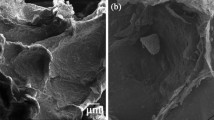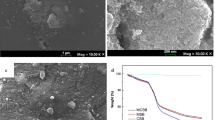Abstract
A novel magnetic polysaccharide composite hydrogel was successfully constructed by using sodium alginate (SA) and carboxymethyl cellulose (CMC) as the backbone and filled with in situ Fe3O4 nanoparticles, which was then employed for removal of heavy metal ion from aqueous solution. The obtained magnetic SA/CMC composite hydrogel was characterized by Fourier transform infrared spectroscopy, fluorescence microscope, thermogravimetric and vibrating sample magnetometer. Effect of contact time, pH and adsorbent dosage on the adsorption of heavy metal ions by the magnetic SA/CMC hydrogel have also been studied. The results show that the prepared magnetic SA/CMC hydrogel can be effectively utilized in the removal of heavy metal ions from aqueous solution. The maximal adsorption capacity of Mn(II), Pb(II), and Cu(II) as calculated from the Langmuir model were 71.83, 89.49, and 105.93 mg/g, respectively. The adsorption process of the magnetic SA/CMC hydrogel on the heavy metal ions can be attributed to ion exchange and chemical adsorption. What’s more, the magnetic hydrogel exhibited high efficiency after four cycles, which indicating it offers great potential for practical application in the removal of heavy metal ions from aqueous solution.










Similar content being viewed by others
References
Jaiswal A, Verma A, Jaiswal P (2018) Detrimental effects of heavy metals in soil, plants, aquatic ecosystem as well as in humans. J Environ Pathol Toxicol Oncol 37:183–197
Ebqa’ai M, Ibrahim B (2017) Application of multivariate statistical analysis in the pollution and health risk of traffic-related heavy metals. Environ Geochem Health 39:1441–1456
Song Q, Li J (2014) Environmental effects of heavy metals derived from the waste recycling activities in China: a systematic review. Waste Manage 34:2587–2594
Li Z, Ma T, Yuan C, Hou JY, Wang QL, Wu LH, Christie P, Luo YM (2016) Metal contamination status of the soil-plant system and effects on the soil microbial community near a rare metal recycling smelter. Environ Sci Pollut Res 23:17625–17634
Zhao Y, Xu M, Liu Q, Wang Z, Zhao L, Chen Y (2018) Study of heavy metal pollution, ecological risk and source apportionment in the surface water and sediments of the jiangsu coastal region, china: a case study of the sheyang estuary. Mar Pollut Bull 137:601–609
Ibrahim F, Nomier MA, Sabik LME, Shaheen MA (2020) Manganese-induced neurotoxicity and the potential protective effects of lipoic acid and spirulina platensis. Toxicol Mech Method 30:497–507
Kumar MR, Reddy KS, Reddy AG, Reddy RA, Reddy DG (2011) Lead-induced hepatotoxicity and evaluation of certain antistress adaptogens in poultry. Toxicol Int 18:62–66
Letelier ME, Lepe AM, Faúndez M, Salazar J, Marín R, Aracena P, Speisky H (2005) Possible mechanisms underlying copper-induced damage in biological membranes leading to cellular toxicity. Chem-Biol Interact 151:71–82
Fu FL, Wang Q (2011) Removal of heavy metal ions from wastewaters: a review. J Environ Manage 92:407–418
Zhu Y, Fan WH, Zhou TT, Li XM (2019) Removal of chelated heavy metals from aqueous solution: a review of current methods and mechanisms. Sci Total Environ 678:253–266
Xiang T, Zhang ZL, Liu HQ, Yin ZZ, Li L (2013) Liu XM (2013) Characterization of cellulose-based electrospun nanofiber membrane and its adsorptive behaviour using Cu(II), Cd(II), Pb(II) as models. Sci China Chem 56:567–575
Hussain MS, Musharraf SG, Bhanger MI, Malik MI (2020) Salicylaldehyde derivative of nano-chitosan as an efficient adsorbent for lead(II), copper(II), and cadmium(II) ions. Int J Biol Macromol 147:643–652
Godiya CB, Cheng X, Li DW, Chen Z, Lu XL (2019) Carboxymethyl cellulose/polyacrylamide composite hydrogel for cascaded treatment/reuse of heavy metal ions in waste water. J Hazard Mater 364:28–38
Hu Y, Wu XY, He X, Xing D (2019) Phosphorylated polyacrylonitrile-based electrospun nanofibers for removal of heavy metal ions from aqueous solution. Polym Adv Technol 30:545–551
Kim MS, Park SJ, Gu BK, Kim CH (2012) Ionically crosslinked alginate carboxymethyl cellulose beads for the delivery of protein therapeutics. Appl Surf Sci 262:28–33
Hu ZH, Omer AM, Ouyang XK, Yu D (2018) Fabrication of carboxylated cellulose nanocrystal/sodium alginate hydrogel beads for adsorption of Pb(II) from aqueous solution. Int J Biol Macromol 108:149–157
Anamizu M, Tabata Y (2019) Design of injectable hydrogels of gelatin and alginate with ferric ions for cell transplantation. Acta biomater 100:184–190
Edathil AA, Alhseina E, Banat F (2019) Removal of heat stable salts from industrial lean methyldiethanolamine using magnetic alginate/iron oxide hydrogel composite. Int J Greenh Gas Con 83:117–127
Swamy BY, Yun YS (2015) In vitro release of metformin from iron (III) cross-linked alginate-carboxymethyl cellulose hydrogel beads. Int J Biol Macromol 77:114–119
Ure D, Mutus B (2021) The removal of inorganic phosphate from water using carboxymethyl cellulose-iron hydrogel beads. J chem Technol Biot 96:38–47
Nagireddy NR, Yallapu MM, Kokkarachedu V, Sakey R, Kanikireddy V, Alias JP, Konduru MR (2011) Preparation and characterization of magnetic nanoparticles embedded in hydrogels for protein purification and metal extraction. J Polym Res 18:2285–2294
Zhu HY, Fu YQ, Jiang R, Yao J, Xiao L, Zeng GM (2012) Novel magnetic chitosan/poly(vinyl alcohol) hydrogel beads: preparation, characterization and application for adsorption of dye from aqueous solution. Bioresource Technol 105:24–30
Wang WB, Zhang HX, Shen JF, Ye MX (2018) Facile preparation of magnetic chitosan/poly (vinyl alcohol) hydrogel beads with excellent adsorption ability via freezing-tawing method. Colloid Surface A 553:672–680
Facchia DP, Cazettac AL, Canesina EA, Almeida VC, Bonaféa EG, Kipperd MJ, Martins AF (2018) New magnetic chitosan/alginate/Fe3O4@SiO2 hydrogel composites applied for removal of Pb(II) ions from aqueous systems. Chem Eng J 337:595–608
Zhang H, Omer AM, Hu ZH, Yang LY, Ji C, Ouyang XK (2019) Fabrication of magnetic entonite/carboxymethyl chitosan/sodium alginate hydrogel beads for Cu (II) adsorption. Int J Biol Macromol 135:490–500
Zhang YP, Li ZK (2017) Heavy metals removal using hydrogel-supported nanosized hydrousferric oxide: synthesis, characterization, and mechanism. Sci. Total Environ. 580:776–786
Zhang SY, Gao H, Guo PT, Li TL, Lin TS, Ding R, Wang ZB, He P (2020) Fabrication and extrusion of the PAAm SAlg hydrogels with magnetic particles. Colloid Surface A 603:125280
Ren HX, Gao ZM, Wu DJ, Jiang JH, Sun YM, Luo CW (2016) Efficient Pb(II) removal using sodium alginatecarboxymethyl cellulose gel beads: preparation, characterization, and adsorption mechanism. Carbohyd Polym 137:402–409
Hu XY, Wang YM, Zhang LL, Xu M, Zhang JF, Dong W (2018) Design of a pH sensitive magnetic composite hydrogel based on salecan graft copolymer and Fe3O4@SiO2 nanoparticles as drug carrier. Int J Biol Macromol 107:1811–1820
Jeddi MK, Mahkam M (2019) Magnetic nano carboxymethyl cellulose-alginate /chitosan hydrogel beads as biodegradable devices for controlled drug delivery. Int J Biol Macromol 135:829–838
Dai HJ, Zhang H, Ma L, Zhou HY, Yu Y, Guo T, Zhang YH, Huang HH (2019) Green pH/magnetic sensitive hydrogels based on pineapple peel cellulose and polyvinyl alcohol:synthesis, characterization and naringin prolonged release. Carbohyd Polym 209:51–61
Kaewprom C, Nuengmatcha P, Chanthai S (2018) Diethyldithiocarbamate doped graphene quantum dots based metal complex nanoparticles by resonance light scattering for green detection of lead(II). Oriental J Chem 34:623–630
Hu Y, Fu X, Chen XD, Zhong NJ (2012) Solution properties of mixed starch/chitosan revealed by resonance light scattering. Chem Res Chin Univ 28:1107–1111
Li J, Tong JJ, Li XH, Yang ZJ, Zhang YC, Diao GW (2016) Facile microfluidic synthesis of copolymer hydrogelbeads for the removal of heavy metal ions. J Mater Sci 51:10375–10385. https://doi.org/10.1007/s10853-016-0258-0
Kosa SA, Al-Zhrani G, Salam MA (2012) Removal of heavy metals from aqueous solutions by multi-walled carbon nanotubes modified with 8-hydroxyquinoline. Chem Eng J 182:159–168
Maity J, Ray SK (2017) Competitive removal of Cu(II) and Cd(II) from water using a biocomposite hydrogel. J Phys Chem B 121:10988–11001
Lee SM, Tiwari D, Choi KM, Yang JK, Chang YY, Lee HD (2009) Removal of Mn(II) from aqueous solutions using manganese-coated sand samples. J Chem Eng Data 54:1823–1828
Li Z, Chen J, Ge Y (2017) Removal of lead ion and oil droplet from aqueous solution by lignin-grafted carbon nanotubes. Chem Eng J 308:809–817
Jiang HB, Yang YR, Lin ZK, Zhao BC, Wang J, Xie J, Zhang AP (2020) Preparation of a novel bio-adsorbent of sodium alginate grafted polyacrylamide graphene oxide hydrogel for the adsorption of heavy metal ion. Sci Total Environ 744:140653
Zhao BC, Jiang HB, Lin ZK, Xu SF, Xie J, Zhang AP (2019) Preparation of acrylamide/acrylic acid cellulose hydrogels for the adsorption of heavy metal ions. Carbohyd Polym 224:115022
Mao SM, Liu XJ, Alharbi NS, Rohani S, Lu J (2018) Fabrication of xanthate-modified chitosan/poly(N-sopropylacrylamide) composite hydrogel for the selective adsorption of Cu(II), Pb(II) and Ni(II) metal ions. Chem Eng Res Des 39:197–210
Acknowledgements
This work was financially supported by the Science and Technology Program of Zhongshan (Grant No. 2020B2068, 2020B2005) and Natural Science Foundation of Guangdong Province (Grant No. 2018A030310477, 2019A1515011843)
Author information
Authors and Affiliations
Contributions
Hu Yong: Conceptualization, Methodology, Writing-original draft, Funding acquisition. Wu Sisi: Experiment investigation, Data curation. Guo Juan: Instrumental analysis, Funding acquisition. Wang Ying: Instrumental analysis. Huang Chao: Writing- review.
Corresponding authors
Ethics declarations
Conflict of interest
The authors declare that they have no known competing financial interests or personal relationships that could have appeared to influence the work reported in this paper.
Additional information
Handling Editor: Maude Jimenez.
Publisher's Note
Springer Nature remains neutral with regard to jurisdictional claims in published maps and institutional affiliations.
Rights and permissions
About this article
Cite this article
Wu, S., Guo, J., Wang, Y. et al. Facile preparation of magnetic sodium alginate/carboxymethyl cellulose composite hydrogel for removal of heavy metal ions from aqueous solution. J Mater Sci 56, 13096–13107 (2021). https://doi.org/10.1007/s10853-021-06044-4
Received:
Accepted:
Published:
Issue Date:
DOI: https://doi.org/10.1007/s10853-021-06044-4




